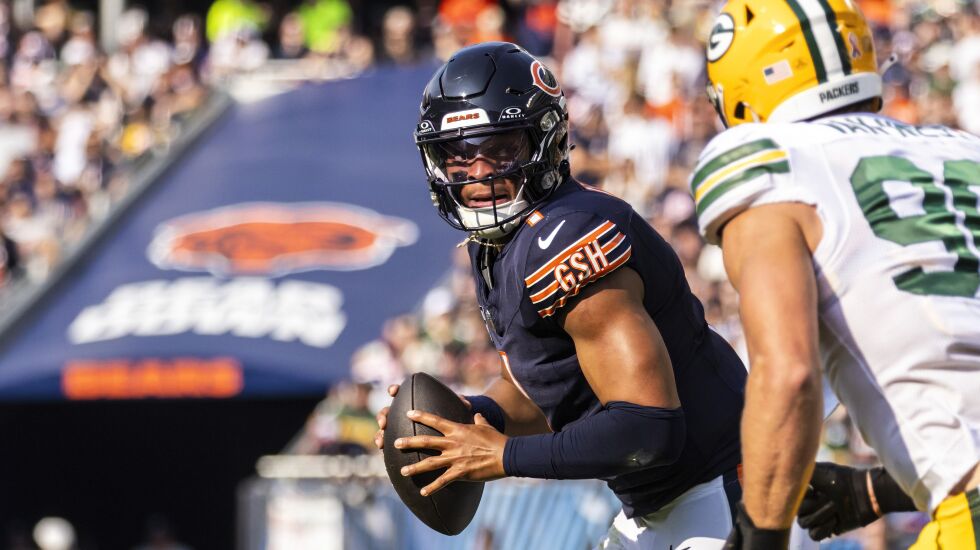
Turnovers come with the territory for some prolific quarterbacks, and they’re somewhat tolerable because they’re going to fill up the stat sheet with yards and touchdowns regardless. Gunslinging and fearlessness have their upside.
Patrick Mahomes, Josh Allen, Joe Burrow and Justin Herbert all threw 25-plus interceptions over the last two seasons, but they also were at least double that — triple, in Mahomes’ case — in touchdown passes and regularly cooked up 300-yard games.
But for Justin Fields and the Bears, who get down the field inches at a time, if at all, there’s little ability to offset those errors. There was minimal margin Sunday once they fell behind the Packers by double digits at the start of the third quarter, and Fields sank them with a pick-six and a lost fumble.
While Fields has had fumbling issues throughout his career, the ball he lost as he scrambled from pressure on a third down in the third quarter seemed to be simply a bad break.
He appeared to have the ball secured properly, and coach Matt Eberflus backed that up, but Packers defensive linemen Kenny Clark and Devonte Wyatt each got a hand on him and squeezed the ball free. On this one, the 29th fumble of his career, there might not have been much he could’ve done differently.
That’s going to happen sometimes.
What can’t happen, however, is the interception that put the Bears out of reach. That play illuminated almost everything the team has been trying to help Fields fix.
He went into this season as the NFL’s best running quarterback, but a long way to go as a passer. He needs to get better at reading the entire field, deciphering defensive coverage, and making good decisions. There were red flags on all three aspects.
On third-and-11 at his own 24-yard line, Fields appeared to be locked in on Darnell Mooney the entire time. That helped Packers linebacker Quay Walker anticipate the throw over the middle, which he intercepted and artfully returned 37 yards for a touchdown and a decisive 38-14 lead.
Fields said after the game he could’ve thrown to wide receiver DJ Moore on the left sideline or checked down to tight end Cole Kmet or running back Roschon Johnson, but he might be referring to what he saw on the tablet on the sideline after the play rather than in real time.
Eberflus said Monday he thought Fields saw all his reads on that play and “ended up trying to squeeze it in there,” but a moment later added, “He certainly needs to scan the field there on that one.”
When it came to figuring out the defense, a Cover 2 zone in this case, Fields either didn’t see Walker or got fooled by him. Either is troubling.
Walker was to Fields’ left and faked like he was helping with Moore, but resettled into his zone before Fields passed, so he should’ve adjusted. Walker was positioned perfectly to break back toward the middle of the field.
All Fields appeared to see was Mooney slipping behind Packers linebacker De’Vondre Campbell. He said afterward he was trying to split a gap between the two defenders, but again, it’s unknown what he saw in the moment as opposed to reviewing it on the sideline.
So how did he miss Walker? What should Fields have picked up on that would’ve alerted him this was a bad idea?
“He probably needs to move on to his next progression,” Eberflus said. “That’s what I would say, without giving too much away.”
Eberflus seemed averse to fully airing out Fields’ error, but he could have a few reasons for suggesting Fields should’ve kept searching. There wasn’t much time to do that at that point, though, and the Bears needed a decent-sized gain to have a chance at continuing the drive.
Nonetheless, anything would’ve been better than a pick-six. Perhaps Eberflus believed Fields should’ve known better against zone coverage and realized that Walker would hold his position.
But even with that lapse, the simple sightline of where he threw should’ve deterred him. And that’s the third red flag.
No matter what Fields caught or missed to that point, when he set himself to throw at the 13-yard line, he was looking at four Packers jerseys in the middle of the field and leading Mooney smack into the middle of them.
Before that pass, Fields was 15 of 21 for 144 yards. That’s moderately efficient, but not nearly productive enough and unlikely to keep the Bears close to Jordan Love and the Packers. Fields averaged 149.5 yards per game last season, which was last among NFL starters.
In the eight previous possessions, the Bears punted three times, had a turnover on downs, Fields lost a fumble, Fields threw a 20-yard touchdown pass to Mooney and they managed two field goals.
The Bears have an incredibly narrow shot at victory if the offense is going to look like that. Everything else, including their defense, would have to be near perfect. And when the odds are that long to begin with, a disastrous mistake like Fields’ fourth-quarter pick-six will wreck any hope of winning.







